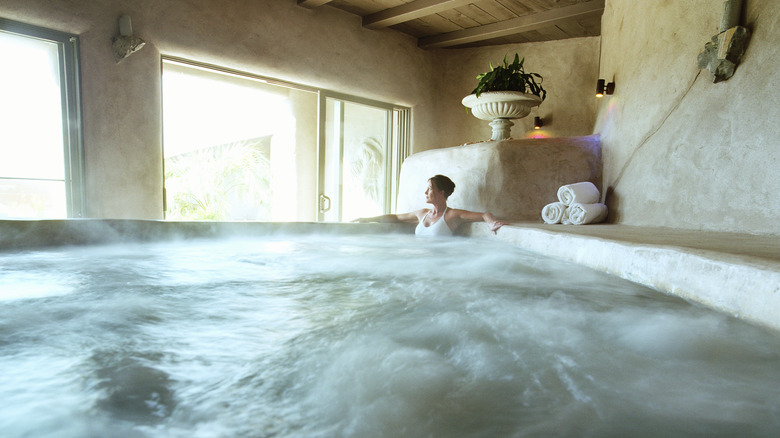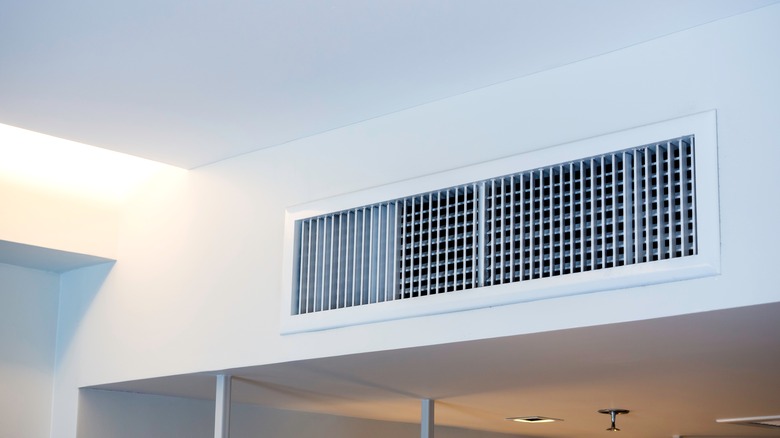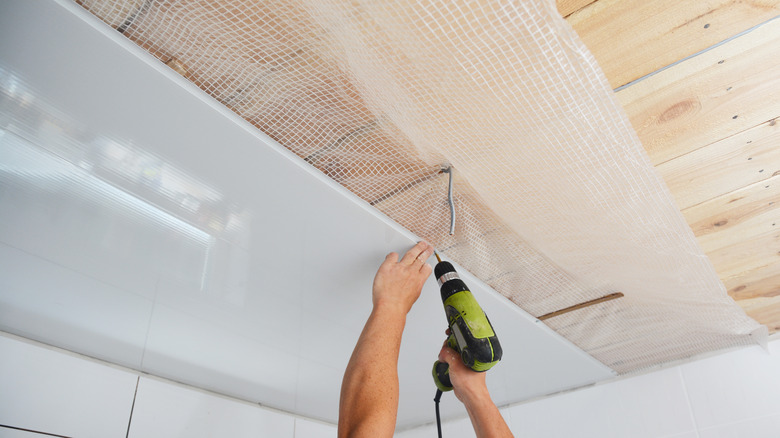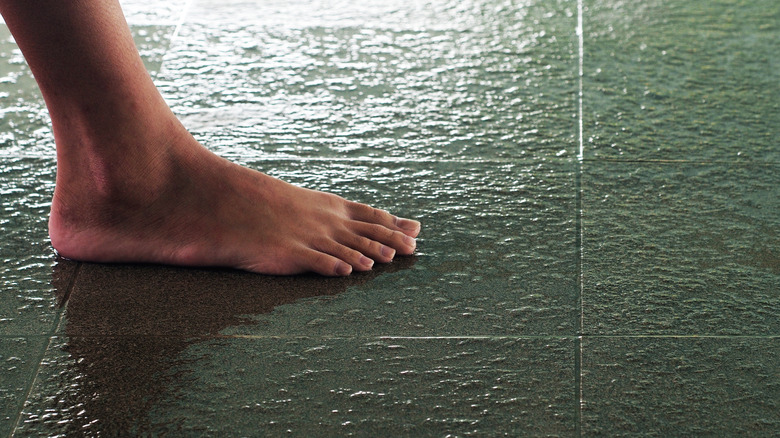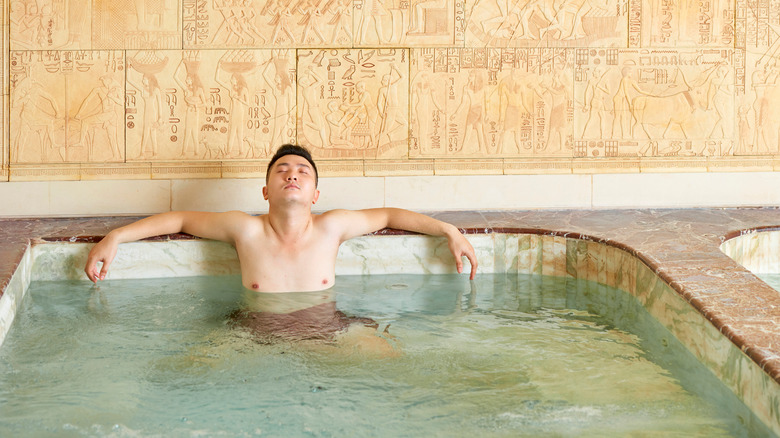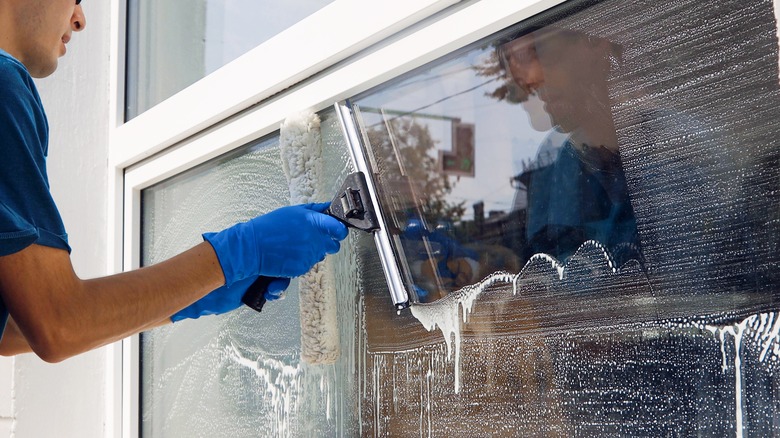What To Know Before Adding An Indoor Hot Tub To Your Home
Many homeowners have considered the addition of a hot tub to their household. Hot tubs offer a variety of great benefits, including stress relief, better sleep, and muscular relaxation, via Healthline. Many people have incorporated hot tubs into the layout of their property, but for those who live in northern regions and don't want to brave the cold each time they go in for a soak, an indoor hot tub might be in the cards. Similarly, a homeowner with additional space on their property or an unused room in the house might consider building an indoor hot tub to capture the luxurious aesthetic and ease of access that this type of installation provides.
An indoor hot tub adds unparalleled privacy to your bathing experience. Unlike an outdoor tub that will sit in view of neighboring backyards or the road, an indoor hot tub removes any onlookers from the equation. Indoor hot tubs don't suffer from the same weather-dependent realities that one located outside is naturally beholden to. If your tub is located outside, you won't be able to jump in for a quick dip in the middle of a thunderstorm. Still, there are some things to know before going all in on this build.
You'll need adequate drainage and ventilation
One unique feature of an indoor hot tub is the reality that drainage and ventilation will need to be built into the environment. Hot tubs placed in the backyard or anywhere outdoors require direct drainage solutions to allow tub cleaning from time to time. However, ventilation isn't a concern because the great outdoors is an equalizer of temperature and moisture.
A hot tub inside your home will need the typical drainage features to fill and remove water from the environment, but your build will also need drains placed throughout the room. Olympic Hot Tub reports that when leaving the water of a hot tub, a person will typically lift and carry as much as a gallon of water out of the tub with them. This liquid will need to be dealt with swiftly to ensure the continued performance of the water feature and the overall health of the room's floors, walls, and other structures. In addition to drainage features, you'll need to properly ventilate the room to return the air in this environment to a state of equilibrium. While using your hot tub, you can expect to add a significant amount of water vapor to the surrounding air, and the ventilation will clear this moisture and keep condensation off of walls, windows, and the floor.
Protecting the room's structure is crucial
In addition to ventilation and drainage features, you'll need to install protective solutions that broadly ensure the room's integrity and the house's structure. A vapor barrier is an essential feature to include when building an indoor hot tub. Energy Vanguard reports that a vapor barrier is essentially plastic sheeting installed inside the wall. It helps regulate the proliferation of condensation within the wall itself. Condensation occurs due to varying temperatures on either end of a surface. With increased moisture content in the air on the hotter side of the surface, condensation can build up on the cooler side. This scenario is what occurs when using an indoor hot tub. Therefore, installing a vapor barrier on the hot side of the wall, according to Energy Vanguard, will help prevent interior condensation from forming.
Condensation isn't necessarily a problem if it develops in places you can clean. However, if the condensation is building up inside your wall, there's not much you can do about it without engaging in a substantial teardown. Condensation inside the wall can lead to structural rot that threatens the integrity of your property. Avoiding this at all costs is critical, and a vapor barrier can help achieve this goal effectively.
Consider options for non-slip flooring
Flooring is the next thing to consider when tackling an indoor hot tub construction project. Naturally, in a hot and humid environment, you can expect to see lots of moisture building up on every surface. This includes the floor. This means that selecting a flooring solution that won't retain moisture or experience significant damage, such as carpeting, is an important piece of the puzzle. Not only do you want to install a durable and long-lasting flooring feature that looks great, but you also need a flooring solution that isn't slippery and poses a safety hazard to you, your loved ones, or your guests.
Greatmats reports that homeowners can use non-slip tiling that looks beautiful, reduces the incidents of potential falls and slips, and will remain durable and functional for a long time. Tile is an obvious choice because once it has been laid in place and grouted, it becomes highly moisture-resistant. This is why homes across the United States rely on the tile for their kitchen and bathroom flooring and why many homeowners and builders install tile running up the bathroom walls or use it as a kitchen backsplash feature behind the stove. GreatMats notes that you can also lay down non-slip tiles incorporating perforations in their surface, allowing water to drain straight through them and down into a basin that will recycle the liquid.
Hire a professional unless you have direct experience
All of this leads to one stark reality you should keep in mind when opting for an indoor hot tub. This process is best left to the professionals. An expert hot tub builder can easily tackle all of these construction requirements. However, a homeowner engaging in a DIY build may easily forget to install the vapor barrier or select inadequate tiles to create a safe and non-slip environment. Olympic Hot Tub notes that this build will be a specialty feature because most hot tubs are installed outside. A certified installer and builder will likely be required when bringing all the pieces into the finished product you're looking for.
It's also important to speak with an architect and builder if you're seeking to add an extension that will serve as the hot tub room rather than repurposing an existing space in your home. Building from the ground up requires a different set of skills and a longer timeline for completion. Bringing together a team of professionals will get the job done right and ensure that your indoor hot tub meets your exact specifications and standards.
The cleaning burden that comes with indoor water features
Lastly, it's important to note that when you add a hot tub to your home, you'll need to budget your time wisely to include the essential cleaning tasks that will come with this feature. Any time you use the hot tub, you'll need to wipe down walls and windows that may have developed condensation during your bathing session. You'll also need a mop or floor squeegee to remove excess liquid that would otherwise sit stagnantly. These tasks are part of "turning off" or "putting away" the feature after use in the same way you'd clean your pots and pans after cooking or wipe down your golf clubs and shoes after playing in muddy conditions.
There is an added requirement, however. Swim University notes that you'll need to clean the hot tub itself from time to time. Draining the water out of your hot tub will be necessary, and using vinegar or olive oil to wipe away grime and the potential bacteria in this hot liquid vat will make the surface of the hot tub sparkle.
